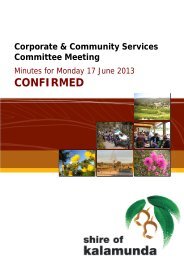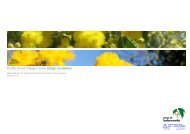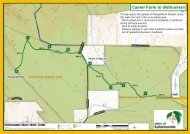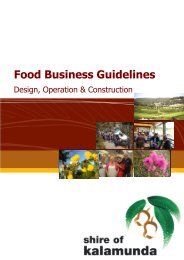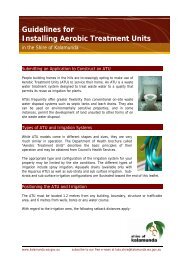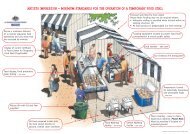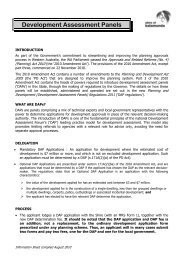Local Biodiversity Strategy: - Shire of Kalamunda
Local Biodiversity Strategy: - Shire of Kalamunda
Local Biodiversity Strategy: - Shire of Kalamunda
You also want an ePaper? Increase the reach of your titles
YUMPU automatically turns print PDFs into web optimized ePapers that Google loves.
The importance <strong>of</strong> both regional ecological linkages and wildlife corridors in<br />
improving the viability <strong>of</strong> local natural areas has been recognised in the development<br />
<strong>of</strong> an ecological linkage target. This target is detailed in Box 9.<br />
Box 9: Preferred Target for Ecological Linkages<br />
Retain and protect viable natural areas that occur within regional<br />
linkages and wildlife corridors. Where practicable, enhance natural<br />
areas which form linkages. Aim to create opportunities to add linkages<br />
to maintain and improve biodiversity values.<br />
9 Representational Targets<br />
Representational targets focus on retaining and protecting a proportion <strong>of</strong> each <strong>of</strong><br />
the characteristic ecological communities found within the <strong>Shire</strong>. Retaining and<br />
protecting a representative sample <strong>of</strong> each ecological community helps halt the rapid<br />
species decline that is associated with clearing and development. These targets also<br />
ensure that ecological communities that are characteristic <strong>of</strong> the area - and therefore<br />
provide a sense <strong>of</strong> place - will remain as an integral part <strong>of</strong> the <strong>Shire</strong>’s landscape into<br />
the future.<br />
Ecological communities with similar representation characteristics have been grouped<br />
together under the same target.<br />
Examples <strong>of</strong> how these targets will be achieved are detailed in Section 13.2.<br />
9.1 Vegetation Complexes and Protection Levels<br />
The <strong>Shire</strong> <strong>of</strong> <strong>Kalamunda</strong> comprises three distinct land areas:<br />
• The Swan Coastal Plain – consisting <strong>of</strong> the major landforms <strong>of</strong> the Pinjarra<br />
Plain, the Bassendean Sands and the Foothills.<br />
• The Darling Scarp, and<br />
• The Darling Plateau.<br />
As vegetation is <strong>of</strong>ten linked to soil type, landform and climate this has created a<br />
very unique and diverse environment within the <strong>Shire</strong> <strong>of</strong> <strong>Kalamunda</strong>. Vegetation<br />
across the landscape varies across the Swan Coastal Plain, the Darling Scarp and the<br />
Darling Plateau. These can be easily recognisable such as the difference between the<br />
Banksia woodlands on the Swan Coastal Plain and the Jarrah forests <strong>of</strong> the Darling<br />
Plateau, or, they can be very subtle differences that are more difficult to distinguish.<br />
This variation across the landscape is the reason behind the high number <strong>of</strong><br />
vegetation complexes that occur. Vegetation complexes are a collection <strong>of</strong> different<br />
vegetation groupings identified through the dominant plant species, <strong>of</strong>ten named<br />
after the soil type on which they grow.<br />
<strong>Local</strong> <strong>Biodiversity</strong> <strong>Strategy</strong> Page 47



